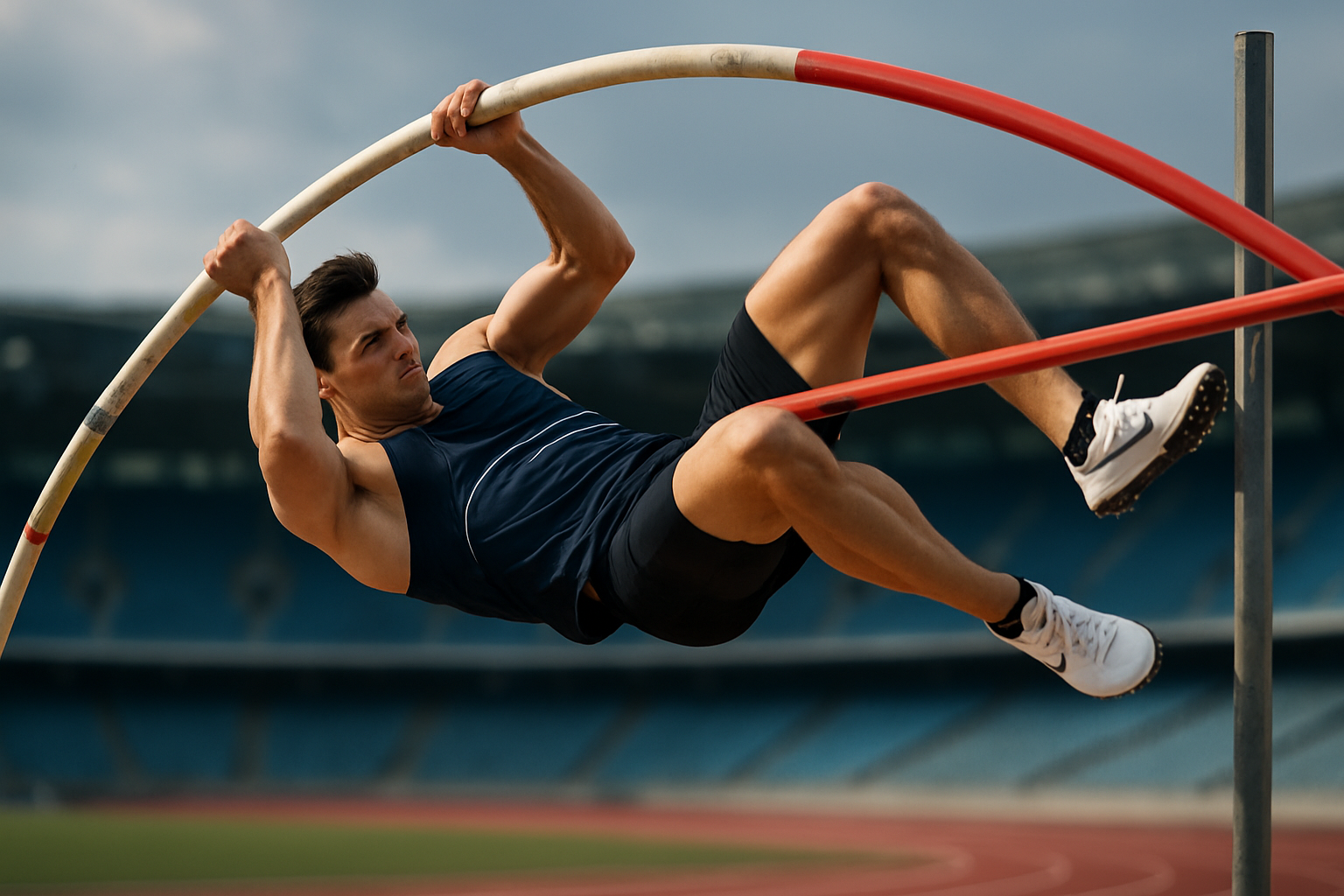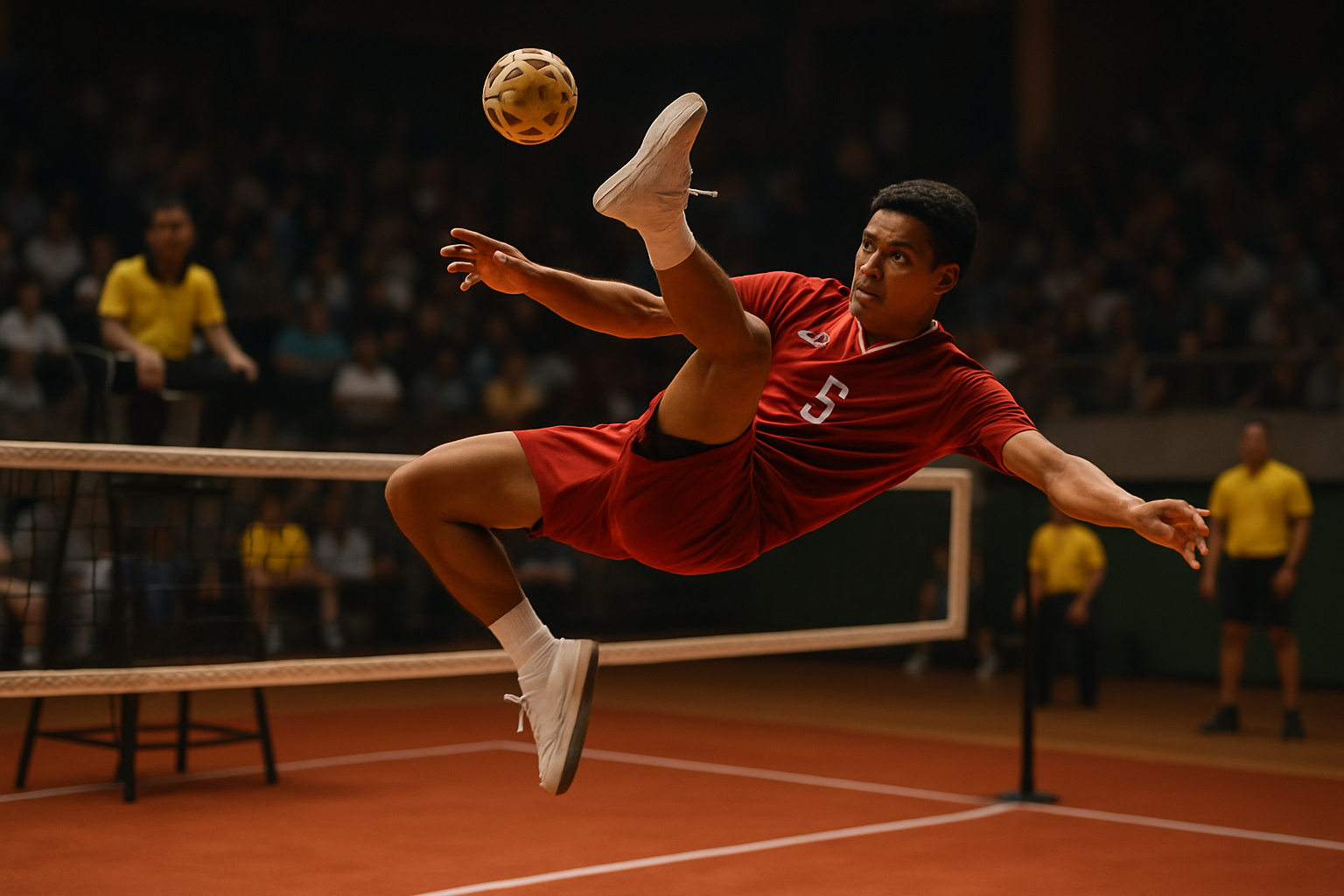Biomechanics of Pole Vaulting: The Art and Science of Defying Gravity
A lone figure sprints down the runway, pole in hand, gathering momentum with each stride. In a breathtaking display of athleticism, the vaulter plants the pole, bends it to near-breaking point, and launches skyward. For a brief moment, they seem to hang suspended in midair before clearing the bar and descending to the mat below. This is pole vaulting, a discipline that marries raw power with precise technique, pushing the boundaries of human capability.

The Approach: Building Kinetic Energy
The success of a pole vault begins long before the athlete leaves the ground. The approach phase is crucial, as it’s where the vaulter generates the kinetic energy necessary to bend the pole and initiate the vault. Biomechanically, this phase is all about maximizing horizontal velocity while maintaining a body position that allows for an efficient transition to the plant and takeoff.
Elite pole vaulters typically reach speeds of 8.5 to 9.5 meters per second during their approach. This velocity is critical, as it directly correlates with the amount of energy that can be transferred to the pole. The approach is usually between 30 to 45 meters long, allowing the vaulter to accelerate to their optimal speed.
During the approach, vaulters must maintain a forward lean of approximately 5 to 10 degrees. This posture helps in two ways: it reduces air resistance and positions the body’s center of mass optimally for the upcoming plant phase. The arms play a crucial role too, with the trail arm remaining relatively static to stabilize the pole while the lead arm drives forward, contributing to the overall momentum.
The Plant and Takeoff: Converting Horizontal to Vertical
As the vaulter nears the end of their approach, they begin the critical phase of planting the pole and taking off. This moment is a biomechanical marvel, involving the rapid conversion of horizontal velocity into vertical momentum.
The plant begins as the vaulter raises their arms, lifting the pole from its carry position to vertical. This motion must be timed perfectly with the final two strides of the approach. As the pole tip enters the box, the vaulter’s body is fully extended, forming a straight line from toe to fingertip.
At takeoff, the vaulter must generate significant vertical force while maintaining their forward momentum. Studies have shown that elite vaulters can produce vertical forces of up to 5 times their body weight during this phase. The takeoff leg acts like a spring, compressing and then explosively extending to drive the vaulter upward.
Simultaneously, the arms begin to pull on the pole, initiating its bend. This bending stores elastic energy in the pole, much like drawing back a bow. The amount of bend achieved is directly related to the vaulter’s approach speed and the stiffness of the pole.
The Swing and Extension: Harnessing Potential Energy
Once airborne, the vaulter enters the swing phase. This is where the stored energy in the bent pole begins to transfer back to the athlete. The goal here is to maximize the conversion of this potential energy into the vaulter’s kinetic energy.
As the pole begins to unbend, the vaulter swings their trail leg forward and up, initiating a powerful hip flexion. This motion helps to rotate the body from a horizontal to a vertical position. Simultaneously, the arms continue to pull, keeping the vaulter close to the pole.
The timing of the swing is crucial. If executed too early, the vaulter may reach vertical before the pole has fully straightened, resulting in a loss of potential height. If too late, the vaulter might miss the opportunity to harness the pole’s energy effectively.
As the pole approaches vertical, the vaulter enters the extension phase. Here, they push off the pole with their arms and extend their body upward. This action, combined with the final straightening of the pole, propels the vaulter to their peak height.
The Turn and Clearance: Precision in the Air
The final phases of the vault – the turn and clearance – are where technique and timing become paramount. As the vaulter reaches their maximum height, they must rotate their body to face the bar. This rotation is initiated by the arms and shoulders and completed by a powerful twist of the hips and legs.
During the turn, the vaulter’s body position changes from vertical to horizontal, with their back parallel to the ground. This position maximizes the distance between the vaulter’s center of mass and the bar, allowing them to clear heights that would otherwise be impossible.
The clearance itself is a delicate balance of body control and timing. The vaulter must arch their back over the bar, timing their hip thrust to push their legs and feet over. Any mistiming or excessive movement here can result in the bar being dislodged.
Biomechanical Factors Influencing Performance
Several key biomechanical factors play crucial roles in determining a vaulter’s performance:
-
Grip Height: A higher grip allows for greater potential energy storage in the pole but requires more strength and speed to execute.
-
Pole Stiffness: Stiffer poles can store more energy but demand greater approach speeds and strength to bend.
-
Take-off Angle: An optimal take-off angle of around 16-20 degrees balances the need for upward momentum with maintaining forward velocity.
-
Body Position at Peak: Achieving a fully extended, vertical position at the peak of the vault maximizes potential height.
-
Center of Mass Trajectory: The path of the vaulter’s center of mass throughout the vault significantly impacts the achievable height.
Understanding these factors allows coaches and athletes to fine-tune technique and equipment selection for optimal performance.
Training Implications of Pole Vault Biomechanics
The complex biomechanics of pole vaulting necessitate a multifaceted training approach. Vaulters must develop a unique combination of speed, strength, and gymnastic ability.
Sprint training is essential for developing the approach speed necessary to bend stiffer poles. Plyometric exercises help improve explosive power for the takeoff and swing phases. Gymnastic training, particularly on the rings and high bar, develops the body awareness and strength needed for the aerial phases of the vault.
Strength training focuses on developing overall power, with particular emphasis on the upper body and core. The ability to pull and push on the pole while controlling body position in the air demands exceptional upper body and core strength.
Flexibility training is also crucial, particularly for the shoulders, hips, and back. The extreme ranges of motion required during the vault necessitate above-average flexibility to prevent injury and maximize performance.
Technological Advancements in Pole Design
The evolution of pole technology has played a significant role in the progression of vault heights over the years. Early poles were made of wood, then steel, and aluminum. The introduction of fiberglass and carbon fiber poles in the 1960s revolutionized the sport.
Modern poles are typically made from a combination of fiberglass and carbon fiber. These materials allow for greater energy storage and return, enabling vaulters to achieve higher clearances. The poles are also tailored to the individual vaulter, with variations in length, stiffness, and weight to match the athlete’s physical characteristics and technique.
Recent advancements have focused on optimizing the pole’s flex characteristics. Some manufacturers are experimenting with variable-stiffness poles, which bend more easily at the bottom while maintaining rigidity at the top. This design aims to make it easier for vaulters to initiate the bend while still providing a strong push at the top of the vault.
Injury Prevention Through Biomechanical Understanding
A thorough understanding of pole vault biomechanics is crucial not just for performance enhancement but also for injury prevention. The high forces and extreme body positions involved in vaulting put athletes at risk for various injuries.
Common injuries in pole vaulting include shoulder dislocations, wrist sprains, and lower back strains. Many of these injuries occur due to improper technique or mismatches between the vaulter’s capabilities and their equipment.
By applying biomechanical principles, coaches and athletes can identify and correct potentially harmful movement patterns. For example, maintaining proper alignment during the plant and takeoff can reduce the risk of shoulder injuries. Similarly, developing adequate core strength helps protect the lower back during the extreme arching required for bar clearance.
Proper progression in training is also essential. Vaulters should gradually increase pole stiffness and grip height as their strength and technique improve, rather than attempting to use equipment beyond their current capabilities.
The Role of Wind and Environmental Factors
Environmental factors, particularly wind, can significantly impact pole vault performance and introduce additional biomechanical considerations. A tailwind can increase a vaulter’s approach speed, potentially allowing for a higher grip and stiffer pole. However, it also requires adjustments in the timing of the plant and takeoff to accommodate the increased velocity.
Conversely, a headwind reduces approach speed, necessitating compensatory measures such as a longer approach or adjustments in pole selection. Crosswinds present their own challenges, potentially disrupting the vaulter’s balance during the aerial phases of the vault.
Temperature and humidity also play roles in pole vault biomechanics. Higher temperatures can make poles more flexible, while cold conditions can increase stiffness. Humidity can affect grip, potentially impacting the vaulter’s ability to control the pole throughout the vault.
Elite vaulters and their coaches must consider these environmental factors when selecting equipment and making tactical decisions during competition. The ability to adapt to changing conditions is a crucial skill in pole vaulting, requiring a deep understanding of the biomechanical principles at play.
Biomechanical Analysis Tools in Pole Vaulting
Advancements in technology have revolutionized how coaches and athletes analyze pole vault technique. High-speed video analysis allows for frame-by-frame examination of each phase of the vault, providing insights that are impossible to discern with the naked eye.
Motion capture systems, similar to those used in the film industry, can create 3D models of a vaulter’s movement. These models allow for detailed analysis of joint angles, velocities, and accelerations throughout the vault.
Force plates embedded in the runway and takeoff area can measure the forces generated during the approach and takeoff phases. This data helps in understanding how different approach strategies and takeoff techniques affect overall performance.
Inertial measurement units (IMUs) worn by the athlete can provide real-time data on body position and movement during the vault. This technology is particularly useful for analyzing the rapid rotations and position changes that occur during the aerial phases.
Computer simulations based on biomechanical models allow coaches and researchers to experiment with different techniques and equipment configurations without the need for physical trials. These simulations can help predict how changes in variables like approach speed or pole stiffness might affect vault height.
The Future of Pole Vault Biomechanics
As our understanding of pole vault biomechanics continues to evolve, so too does the potential for further advancements in technique and performance. Several areas of research and development show promise for the future of the sport:
-
Personalized Equipment Design: Advanced 3D printing technologies may soon allow for the creation of poles tailored to an individual vaulter’s biomechanics, optimizing energy transfer and reducing injury risk.
-
Virtual Reality Training: VR systems could provide vaulters with a safe environment to practice technique and timing, allowing for more repetitions without the physical toll of full vaults.
-
AI-Assisted Coaching: Machine learning algorithms could analyze vast amounts of biomechanical data to identify subtle technique optimizations for individual athletes.
-
Improved Energy Return Materials: Research into new composite materials may lead to poles capable of storing and returning energy even more efficiently than current designs.
-
Wearable Feedback Systems: Real-time biomechanical feedback during training could help vaulters make immediate adjustments to their technique.
As these technologies develop, the limits of human performance in pole vaulting may be pushed even further. However, the fundamental biomechanical principles that govern the sport will remain constant, continuing to challenge athletes and scientists alike in their quest to defy gravity.
Conclusion: The Eternal Dance of Physics and Human Potential
Pole vaulting stands as a testament to the incredible capabilities of the human body when guided by scientific understanding and relentless pursuit of excellence. The biomechanics of this sport reveal a complex interplay of forces, timing, and technique that pushes the boundaries of what we thought possible.
From the explosive power of the approach to the balletic grace of the aerial phases, every moment of a pole vault is a study in applied physics and human kinetics. The continued evolution of technique, training methods, and equipment, all informed by biomechanical research, promises to keep pushing vault heights to new records.
Yet, for all our scientific understanding, there remains an element of artistry in pole vaulting. The fluid coordination of mind and body, the split-second decisions made in mid-air, the sheer courage required to launch oneself skyward – these aspects remind us that at its core, pole vaulting is a profoundly human endeavor.
As we look to the future, the biomechanics of pole vaulting will undoubtedly continue to fascinate scientists, inspire engineers, and challenge athletes. In this eternal dance between physics and human potential, we find not just the thrill of athletic achievement, but a reflection of our unending quest to surpass our limitations and reach ever greater heights.





